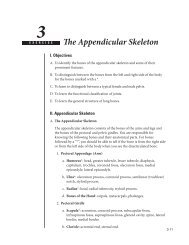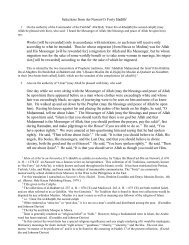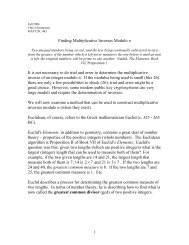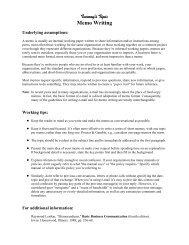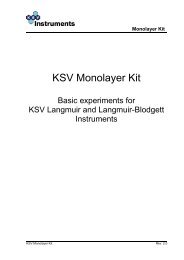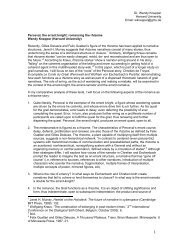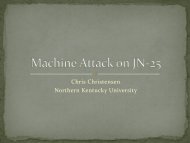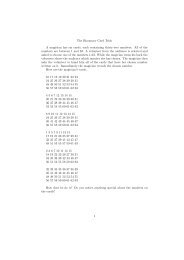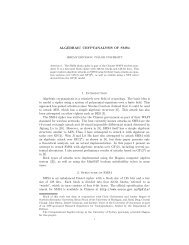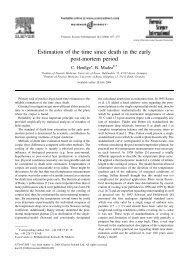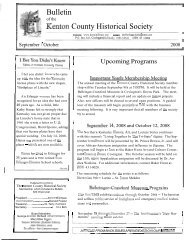View the scanned document - Northern Kentucky University
View the scanned document - Northern Kentucky University
View the scanned document - Northern Kentucky University
You also want an ePaper? Increase the reach of your titles
YUMPU automatically turns print PDFs into web optimized ePapers that Google loves.
paid shares. The member repaid <strong>the</strong> loan by continu-<br />
ing to make <strong>the</strong> reg&+ GGZfiKgie payments arm-<br />
well as loan interest =is interest plus any o<strong>the</strong>r fees<br />
minus operating expenses (which typically accounted<br />
for only one to two percent of revenues) determined<br />
<strong>the</strong> profit of <strong>the</strong> thrift, which <strong>the</strong> members rece~ived ~~.<br />
as dividends. j<br />
A major difference between <strong>the</strong> B&L associations<br />
and commercial banks, besides <strong>the</strong> types of mortgage<br />
loans <strong>the</strong>y offered, was <strong>the</strong>ir role in society. B&L's<br />
vere not-for-profi: cooperati-~e organizations, usually<br />
established and managed by a board of local business-<br />
men directly elected by <strong>the</strong> membership. Their small<br />
size, often with less than 200 members, was a result of<br />
<strong>the</strong> well-defined population <strong>the</strong>y served, perhaps a<br />
single parish or neighborhood. Finally, <strong>the</strong> leaders<br />
, behind <strong>the</strong>se associations often believed that <strong>the</strong>y<br />
were part of a broader social reform movement; not<br />
only were <strong>the</strong>y helping people own <strong>the</strong>ir own home;<br />
<strong>the</strong>y were teaching and promoting thrift and mutual<br />
cooperation. 6<br />
In Nor<strong>the</strong>rn <strong>Kentucky</strong>, this aspect of social responsibility<br />
was perhaps <strong>the</strong> most compelling reason for<br />
<strong>the</strong> proliferation of building and loan associations -<br />
continuing <strong>the</strong> time-honored German tradition of <strong>the</strong><br />
barwe~ezn, <strong>the</strong> German word for a building associa-<br />
tion. It was a cultural expectation of every German<br />
working man to put aside an amount, be it large or<br />
small, of every pay period in a savings institution.<br />
This "'methodical thrift' was considered a first essen-<br />
tial to good citizenship -when a young man who was<br />
to succeed became a member of 'some financial insti-<br />
tution' upon leaving school and obtaining his first<br />
employment - to do o<strong>the</strong>rwise branded him with a<br />
- .<br />
fatal future, for frugality was a family watchword."<br />
The leaders of <strong>the</strong> German American community of<br />
<strong>the</strong> east side of Covington certainly felt a moral im-<br />
perative to establish a local bauverein as soon as <strong>the</strong>y<br />
had <strong>the</strong> abilitv to do so.<br />
The association eventually moved into a wood<br />
frame office building immediately next door to 1221<br />
Garrard Street (now demolished); this was to be <strong>the</strong><br />
home of <strong>the</strong> <strong>Kentucky</strong> Perpetual Building and Loan<br />
Association until 1915. At that time, <strong>the</strong> association<br />
built a one-story brick office building at 1209 Scott<br />
Street (now demolished). By 1927, <strong>the</strong> association. ___.<br />
~ .<br />
- . . ~<br />
-*. ~.~<br />
once again needed larger accommodations and pur-<br />
chased a commercial property located at <strong>the</strong> north-<br />
east comer of Eleventh and Scott Streets; this build-<br />
ing was a converted three story brick residential struc-<br />
ture and it, too, was soon inadequate for <strong>the</strong> needs of<br />
<strong>the</strong> association. In 1941, this building was replaced<br />
with a "modern office structure."<br />
Building at 1221 Garrard Street<br />
Five years before <strong>the</strong> construction of <strong>the</strong> new<br />
building, <strong>the</strong> organization had received its federal<br />
charter, <strong>the</strong> first in Nor<strong>the</strong>rn <strong>Kentucky</strong>, and its name<br />
was changed to <strong>Kentucky</strong> Federal Savings and Loan.<br />
A federal charter guaranteed that <strong>the</strong> institution's de- 1<br />
posits were insured by <strong>the</strong> Federal Savings and Loan<br />
Insu~ance Corporati0~4FSLIC). &&is time, <strong>the</strong> institution<br />
was no longer simply a neighborhood en-<br />
/<br />
deavor but a professional organization staffed by<br />
I<br />
trained personnel. The board, however, continued to<br />
be made up of local prominent businessman whose<br />
names still resonate as familiar in our community:<br />
Clement ~ Scheper, ~~p-~<br />
~ George Klaene, ~~- ~ George<br />
i<br />
~~ Howell,<br />
~ ~- -~ p~~~~<br />
~ ~<br />
William Hoppenjans, Frank An<strong>the</strong>, L. F. Muthing,<br />
John B. Theissen and William Wehrman, to name<br />
just a few? !<br />
The national housing boom of <strong>the</strong> post WWi<br />
years was also experienced locall-y and, in 1957, under<br />
<strong>the</strong> leadership of president F.J. An<strong>the</strong>, <strong>the</strong> burgeon-<br />
ing <strong>Kentucky</strong> Federal announced <strong>the</strong> need for a larger<br />
and more up-to-date facility. Tivo adjacent houses<br />
were razed and plans were drawn for a contemporary



